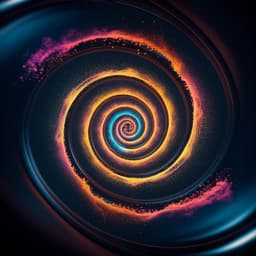
Chemistry
High-throughput phase elucidation of polycrystalline materials using serial rotation electron diffraction
Y. Luo, B. Wang, et al.
This groundbreaking research by Yi Luo, Bin Wang, Stef Smeets, Junliang Sun, Weimin Yang, and Xiaodong Zou showcases the innovative use of serial rotation electron diffraction to identify multiple zeolite phases in complex polycrystalline materials, pushing the boundaries of high-throughput phase identification.
~3 min • Beginner • English
Introduction
The study addresses the need for rapid and reliable phase elucidation in complex polycrystalline materials where conventional X-ray diffraction (single-crystal or powder) is limited by small crystal size, peak overlap, multiple phases, ultra-low phase contents, and similar or large unit cells. Three-dimensional electron diffraction (3D ED) can probe nanoscale crystals but traditionally requires manual, biased, and time-consuming crystal selection. The authors propose SerialRED, an automated serial rotation electron diffraction workflow combined with hierarchical cluster analysis, to perform high-throughput, objective phase identification and structure determination. They demonstrate its utility on complex zeolite products synthesized from multiple framework T atoms (Si, Ge, Al or B) using a simple OSDA, aiming to uncover hidden phases, quantify phase compositions, rationalize synthesis pathways, and accelerate materials development.
Literature Review
X-ray diffraction has long been the standard for phase analysis and structure determination, with SCXRD requiring large single crystals and PXRD suffering from peak overlap, particularly in mixtures, low-content phases, and complex/low-symmetry structures. Advances in 3D ED enable structure elucidation from crystals down to ~50 nm and have been successfully applied to challenging polycrystalline materials. Serial electron diffraction (SerialED) introduced fully automated snapshot-based data collection, later extended to serial rotation electron diffraction (SerialRED), enabling automated screening and data collection from hundreds of crystals and coupling phase analysis with structure solution via cluster analysis. In zeolite synthesis, simple and complex OSDAs have historically directed framework formation; DMAP has yielded SFO, POS, and UOE frameworks. Prior work indicates combined framework T atoms (Si, Ge with Al or B) influence building units (e.g., s4r, d4r) and pore sizes. Despite this knowledge, complex products often remain partially characterized or missed due to analytical limitations—SerialRED seeks to overcome these challenges.
Methodology
Synthesis: Zeolites were synthesized hydrothermally using multiple framework T atoms ([Si,Ge,Al] or [Si,Ge,B]) and a simple pore-filling OSDA (4-dimethylaminopyridine, DMAP). The Si/Ge molar ratio was varied from 5 to 15 and (Si+Ge)/T (T = Al or B) from 5 to 100. Typical crystallization was at 170 °C for 10 days. Product A (Si/Ge=10, (Si+Ge)/Al=15) and Product B (Si/Ge=5, (Si+Ge)/Al=12.5) were selected for detailed study; product B used a two-step heating profile (110 °C 1 day, then 170 °C 5 days). PXRD and SEM provided initial phase/morphology screening; cRED was used to identify IWV in product B.
SerialRED data collection and processing: Automated SerialRED was performed on a JEOL JEM2100 LaB6 (200 kV) with a Timepix detector using Instamatic. Samples were dispersed in ethanol and dropped on a carbon-coated TEM grid. A partially condensed parallel beam and virtual selected-area aperture were used; exposure time 0.5 s per frame with periodic defocus for crystal tracking and adaptive tracking frequency. For product A, 6 h of data collection yielded 321 3D ED datasets; on-the-fly indexing via DIALS resulted in 146 indexed datasets. Seventy-seven datasets with rotation range >20° were used for phase analysis. Unit-cell-based hierarchical cluster analysis (HCA) in edtools used a Euclidean distance metric combining Δa, Δb, Δc, and Δ(sin α), Δ(sin β), Δ(sin γ). Intensity-based HCA (Pearson correlation distance) was then used to select and merge the most correlated datasets within each phase for structure analysis. Structures were solved by direct methods (SHELXT) and refined kinematically (SHELXL/Shelxle). Camera length was fixed for all datasets; unit cell errors were mitigated by consistent optics and eucentric conditions.
Complementary characterization: PXRD (laboratory) and SPXRD (SSRF BL14B1, λ = 0.68950 Å) were used for Pawley fits and Rietveld refinement (TOPAS v.6). Additional characterizations included SEM, N2 physisorption, ICP, solid-state NMR, FTIR (pyridine adsorption), and NH3-TPD. Catalysis testing evaluated IPN isomerization in a 100 ml autoclave (35 g IPN, 1.5 g catalyst, autogenous pressure, 250 °C, 6 h), comparing product B against MOR and SFE catalysts prepared in acid form via calcination and ammonium exchange.
Data analysis parameters: HCA unit-cell clustering used an example cut threshold of 2.0 in Euclidean distance to delineate clusters. Intensity-based clustering was applied primarily for dataset selection/merging due to limited completeness of individual SerialRED datasets.
Key Findings
- SerialRED throughput and indexing: In product A, a 6 h SerialRED run yielded 321 datasets; 146 were indexed by DIALS, and 77 datasets (rotation >20°) were used for phase analysis.
- Phase identification in complex mixtures: HCA (unit-cell-based; cut threshold ~2.0) revealed five zeolite framework types in product A: RTH (needle-like), IWV (plate-like), CTH (2D, 14×12-ring, plate-like), UOE (2D, 10×8-ring, needle-like), and POS (needle-like). RTH, IWV, and CTH were major phases; UOE and POS were minor/ultra-low-content phases. Minor phases were not detected by PXRD and could not be distinguished by SEM due to similar morphologies.
- Structure solution: Merged 3D ED datasets per phase provided sufficient data for direct structure solution in SHELXT; Pawley fits of PXRD confirmed RTH, IWV, and CTH as major contributors in product A.
- Resolving similar unit cells and morphologies: In product B (initially thought pure plate-like), SerialRED identified both IWV and minor CTH despite similar morphology and two similar unit-cell dimensions. SerialRED detected 27 IWV and 9 CTH crystals (≈75% vs 25% by count). SPXRD Rietveld refinement gave 67 wt% IWV and 33 wt% CTH, indicating SerialRED can enable quantitative phase analysis when sampling sufficient crystal numbers.
- Synthesis–structure relationships: Analysis across compositions showed related building chains/layers (TON, NON, IWV, CTH) arising from Si-based systems with small Ge; non units were promoted by small B addition, and d4r units by Al with substantial Ge. Consequently, IWV and CTH (containing ton, non, d4r) were promoted by introducing Al and Ge into TON-type systems.
- Economical OSDA: Large- and extra-large-pore zeolites SFE, IWV, and CTH were synthesized using simple, commercially available DMAP rather than bulky, costly OSDAs, improving scalability.
- Catalysis: Product B (IWV/CTH mixture) exhibited higher catalytic efficiency for isopropylnaphthalene isomerization than MOR and SFE, attributed to 2D large/extra-large pores and moderate acidity, suggesting enhanced accessibility for bulky molecules.
- Practical impact: SerialRED objectively samples hundreds of crystals, reducing human bias and revealing hidden/trace phases that guide rational synthesis and potential industrial scale-up.
Discussion
The results demonstrate that SerialRED effectively overcomes core limitations of PXRD and manual 3D ED for complex polycrystalline mixtures by automating crystal selection and rapidly acquiring 3D ED datasets from large crystal populations. In product A, SerialRED identified five coexisting zeolite frameworks, including ultra-low-content and morphology-similar phases that PXRD and SEM could not resolve. In product B, it differentiated phases with similar unit-cell parameters and morphology and provided phase fractions by crystal counts that broadly agreed with SPXRD-derived weight percentages, highlighting its potential for quantitative analysis given sufficient sampling. The comprehensive phase maps enabled by SerialRED clarified how T-atom composition (Si, Ge, Al, B) governs formation of key building units (ton, non, d4r) and framework interrelations (TON/NON/IWV/CTH), informing rational design and tuning of synthesis conditions. The approach reduces workflow bottlenecks in high-throughput materials discovery, enables early detection of valuable phases that might otherwise be missed, and contributes to scalable synthesis strategies using simple OSDAs. The improved catalytic performance of the IWV/CTH mixture underscores the functional relevance of accurate phase information for application development.
Conclusion
SerialRED provides a high-throughput, automated route to determine phase compositions and structures in complex polycrystalline materials using only trace sample amounts. Applied to zeolite synthesis products, it identified five phases (RTH, UOE, POS, IWV, CTH) within a highly complex mixture, including trace and morphology-similar phases that eluded PXRD and conventional 3D ED. It also demonstrated potential for quantitative phase analysis that agrees with SPXRD when sampling many crystals. The detailed phase information revealed structure–composition relationships among framework T atoms, enabling rational synthesis and economically viable routes to large/extra-large pore zeolites with simple OSDAs. Beyond zeolites, SerialRED is positioned to accelerate discovery and development across diverse polycrystalline materials (minerals, oxides, ceramics, semiconductors, organics, pharmaceuticals) and polymorph studies. Future work can focus on enhancing dataset completeness and clustering strategies to further improve phase discrimination and quantitation.
Limitations
- Incomplete indexing and data quality: Of 321 datasets collected for product A, only 146 were indexed and 77 used for phase analysis; some datasets remained unclassified due to crystal agglomeration or poor data quality.
- Unit-cell accuracy: SerialRED unit-cell parameters can have large errors from optical distortions, goniometer instability, and camera length calibration; careful, consistent optics and stable stages are required.
- Similar unit-cell ambiguity: Phases with very similar unit cells risk misclassification in unit-cell-based clustering and ambiguous reflection indexing; intensity-based clustering may fail with low completeness.
- Dataset completeness: Limited rotation ranges reduce completeness, constraining intensity-based clustering for phase analysis; in this work, intensity clustering was used mainly for dataset selection/merging.
- Quantitation: HCA-based crystal counts approximate but do not directly equate to weight fractions; accurate quantitative phase analysis still benefits from complementary SPXRD/Rietveld and from sampling larger crystal numbers.
- Generalizability: Thresholds (e.g., Euclidean cut at ~2.0) and clustering results may be system-dependent and require tuning.
Related Publications
Explore these studies to deepen your understanding of the subject.







